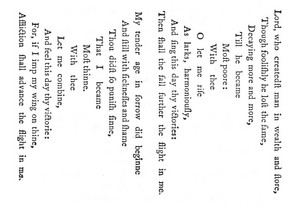Concrete poetry, to put it simply, is one of the most basic and modern forms of poetry around. Often called shape poetry, concrete poems are deceptively simple-take the words of a poem, and then move them around in a new and unique way. This is called reordering the typography, and it is the key element to what concrete poetry is. Often this can mean forming a shape out of the words, like this:
t
ree
treet
treetre
treetreet
treetreetree
tre
et
Did you see what I did with there? I simply took the letters of the word tree and arranged them to look like a tree on the page. Interestingly enough, that’s all it takes to make a concrete poem, albeit a simple one that won’t be getting either of us bonus points in class. Just remember, concrete poetry is about moving the words around, breaking away from straight-line stanzas. Now that you’ve got the basics of concrete poetry, let’s talk about some of the details.
Generally speaking, there are two forms of concrete poems-American and European. The differences between the two are easy enough, and often they get blended together.
American concrete poetry is usually based around forming a shape with words. In fact, most American concrete poets call themselves shape poets, or their work visual poetry. My example above about trees is an American concrete poem.
To contrast that, European poetry is more typography based-that’s a fancy word that means Europeans care more about moving the words around to unusual spots on the page. Though they can form a shape, European concrete poetry is meant to be read visually and often all in one go. When reading a concrete poem from this school, try to think of reading it as if it were a piece of art. You can get the gist of the poem with one glance, and then focus in on minute details. Here is my tree poem redone in this style:
Tree everywhere I
-s are
Look nothing
but trees trees trees.
Again, not a lot of susbtance in the poem, but you get the idea. By moving the words around I break up the lines and the force of the words in different ways. If I had more to say-if I were actually writing a concrete poem, that is-I could arrange the phrases in such a way that my meaning is complimented by the visual elements. I could break up the words to make new words, or add a sub-text to the piece by using typography to convey more than one theme. Those are more complex ideas, but in the most basic sense my example is still a European concrete poem.
That’s all you need to know about concrete poetry! All concrete poems are meant to be read in a visual sense, never aloud. Take eitehr of my examples and read them to yourself, ignoring any shape and simply sounding out the words-you’ll very quickly see what I mean. Concrete poetry is, above all, visual, visual, visual.
If you’re rearing at the bit to learn more, check out the works of E.E. Cummings, or Ezra Pound. Or do a search for shape poets, or visual poetry. If you really like the style, try writing a few concrete poems of your own. There is no wrong way to make one, so get out there and do it!
Good luck, and happy writing!
Sources:
Mary Ellen Sort, “Concrete Poetry: A World View.” UbuWeb






